
US Manufacturing ISM Signals Accelerating Stagflation As PMI Turns Downright Apocalyptic
Ahead of Friday’s payrolls report, there were rising expectations that the economic rebound observed in the past two weeks – and following the dismal July jobs report – would persists. Alas, those hopes were promptly crushed moments ago when shortly after a dismal US Manufacturing PMI report, which printed in its final iteration at 47.9, below the prelim print of 48.0 and below the 48.1 estimate, the more closely watched Manufacturing ISM report came in even uglier, printing at the 5th consecutive contractionary level of 47.2, which while a modest rebound from the 2024 low of 46.8 hit last month, missed estimates of a 47.5 print. And while the two surveys have frequently diverged in the past, there is clear agreement between the two since the early summer: the US manufacturing sector is imploding, and the economic contraction is accelerating.
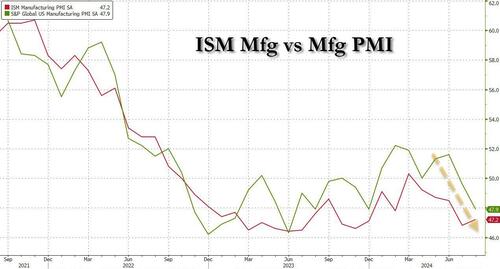
The contraction was broad based, with the index posting declines in the all important New Orders, Production, and Employment.
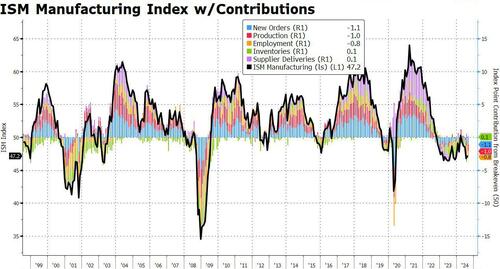
While the Employment subindex did post a modest rebound – while still stuck deep in contraction – which suggests that Friday’s jobs report will come stronger than expected, the bad news is that new orders declined at their fastest rate since June 2023.

And while most output subindexes remain deep in contraction territory, one continues to rise: the one that should not be doing that: we are talking of course about prices paid which rose again, from 52.9 to 54.0, beating estimates of 54.0, and resuming its ascent since the start of 2023. In fact, compared to an 8-month lagging CPI print, one can be assured that we have seen the lowest CPI prints for this cycle.
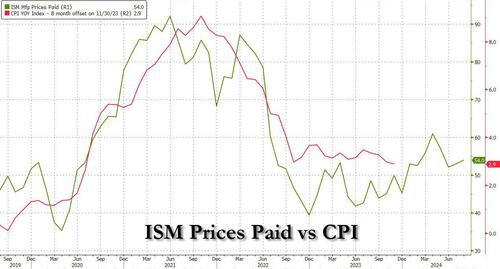
Adding insult to injury, the closely watched ISM New Orders/ Inventory ratio suddenly plunged back to recession levels…
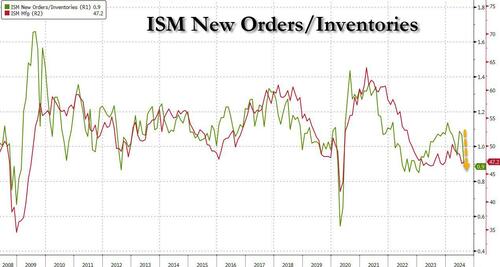
… because inventories unexpectedly soared the most last month (back over 50 from 44.5) in the past decade as end-demand suddenly disappears…
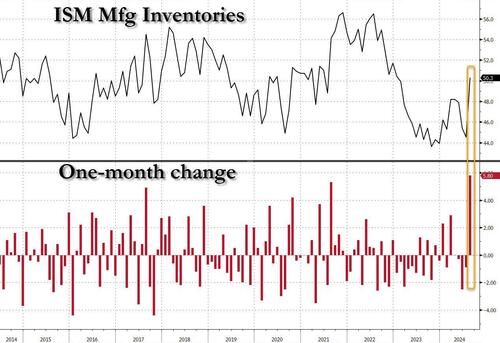
… signaling that the manufacturing pipeline is now hopelessly clogged, price liquidations are imminent and mass layoffs are about to begin!
While traditionally a 50 print in the ISM is the cutoff for contraction, the highly politicized ISM report was quick to claim that a „manufacturing PMI above 42.5 percent, over a period of time, generally indicates an expansion of the overall economy”: spoiler alert: it does not, but it is an election year, so anything goes. In any case, not even the ISM was able to put much more lipstick on this pig and explained that this „contractionary expansionary” print was hardly the stuff expansions are made off with ISM chair Tim Fiore saying that „the past relationship between the Manufacturing PMI® and the overall economy indicates that the August reading (47.2 percent) corresponds to a change of plus-1.3 percent in real gross domestic product (GDP) on an annualized basis.”
Translation: we are this close to stall speed…. and the survey respondents by large agreed:
- “A noticeable slowdown in business activity. Staffing and production rationalization has been triggered. Previous optimism about future growth has been dashed.” [Chemical Products]
- “Backlog has dropped in half as invoicing remains strong, but orders have slowed significantly. Hoping to see orders pick back up for the fourth quarter and into 2025 but expect third quarter to remain slow for incoming orders.” [Transportation Equipment]
- “After a slow start and lower year-over-year sales volume during the first half of the year, we are now seeing a mild increase in year-over-year sales volume, along with more steady growth.” [Food, Beverage & Tobacco Products]
“Business outlook is good. Recovery from the electronics slowdown is strong for the second half of the year.” [Computer & Electronic Products] - “New order intake is sluggish at best. Interestingly, even though orders are down, inquiries are up. Customers have indicated capital has been approved for equipment purchases, but they were directed to put projects on hold until the fourth quarter of 2024. This indicates the uncertainty around the election. We anticipate a strong end of the year, with a rise in backlog going into 2025.” [Machinery]
- “Our order levels are on a slow, steady decline; it looks like the trend will continue through the end of the year. We are downsizing through attrition and not hiring backfills, but there have been no layoffs to date. The bright spot is a few customer programs have helped increase orders for parts, resulting in some production areas to be very busy while others have little work. Redeploying people where we can.” [Fabricated Metal Products]
- “Business is cooling down, and we don’t expect a rebound until after the election is over. As we build our 2025 budget, we continue to have deep concerns about the added environmental costs on energy.” [Paper Products]
- “Order book remains strong for now. We are preparing for a slowdown in U.S. auto sales. We are running overtime to keep pace, as hiring hourly employees has been difficult. Some walk off the job within hours because they cannot handle factory work.” [Primary Metals]
- “High interest rates are curtailing consumer spending on large discretionary spending for furniture, cabinetry, flooring and decorative trim, which has affected our industry sales potential. At the same time, pent-up demand seems to be growing for housing and remodeling. Interest rate cuts may not happen soon enough to have an impact this year.” [Wood Products]
But if the ISM was bad, than the final August S&P PMI report was downright apocalyptic and as the following comments from Chris Williamson, Chief Business Economist at S&P Global Market Intelligence, made clear:
“A further downward lurch in the PMI points to the manufacturing sector acting as an increased drag on the economy midway through the third quarter. Forward looking indicators suggest this drag could intensify in the coming months.
“Slower than expected sales are causing warehouses to fill with unsold stock, and a dearth of new orders has prompted factories to cut production for the first time since January. Producers are also reducing payroll numbers for the first time this year and buying fewer inputs amid concerns about excess capacity.
“The combination of falling orders and rising inventory sends the gloomiest forward-indication of production trends seen for one and a half years, and one of the most worrying signals witnessed since the global financial crisis.
“Although falling demand for raw materials has taken pressure off supply chains, rising wages and high shipping rates continue to be widely reported as factors pushing up input costs, which are now rising at the fastest pace since April of last year.”
Bottom line: core outputs sinking as input costs and inflation expectations are once again surging: not exactly the ’data-dependence’ that dovsh Fed members are hoping to see. But at least the Fed Chair will finally see that „stag” and the „flation” he had so much trouble spotting just a few months ago…
Tyler Durden
Tue, 09/03/2024 – 10:31
















